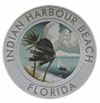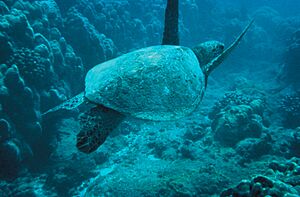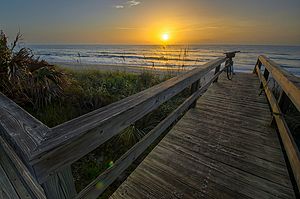Indian Harbour Beach, Florida facts for kids
Quick facts for kids
Indian Harbour Beach, Florida
|
||
|---|---|---|
| City of Indian Harbour Beach | ||
|
||
| Motto(s):
"The Greatest Little City in Florida!"
|
||
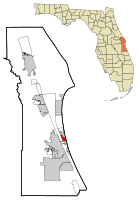
Location in Brevard County and the state of Florida
|
||
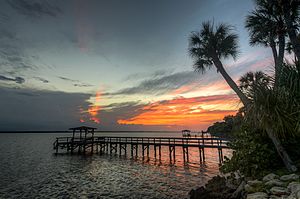 |
||
| Country | ||
| State | ||
| County | ||
| Incorporated | June 6, 1955 | |
| Government | ||
| • Type | Council-Manager | |
| Area | ||
| • Total | 2.67 sq mi (6.91 km2) | |
| • Land | 2.09 sq mi (5.42 km2) | |
| • Water | 0.57 sq mi (1.49 km2) | |
| Elevation | 10 ft (3 m) | |
| Population
(2020)
|
||
| • Total | 9,019 | |
| • Density | 4,309.13/sq mi (1,664.15/km2) | |
| Time zone | UTC-5 (Eastern (EST)) | |
| • Summer (DST) | UTC-4 (EDT) | |
| ZIP code |
32937
|
|
| Area code(s) | 321 | |
| FIPS code | 12-33450 | |
| GNIS feature ID | 0284502 | |
Indian Harbour Beach is a lovely coastal city in Brevard County, Florida, United States. It's a part of the larger Palm Bay–Melbourne–Titusville area. In 2020, about 9,019 people lived here. This was an increase from 8,225 people in 2010.
The city is located about 3 miles (4.8 km) north of Indialantic and south of Satellite Beach. Indian Harbour Beach is special because it's the first and only city on the East Coast of the United States to be recognized as a "NOAA Tsunami Ready community." This means it has plans in place to keep people safe if a tsunami ever threatened the coast.
Contents
A Look at Indian Harbour Beach History
Indian Harbour Beach was officially started on June 6, 1955. It was founded by three people: W. Lansing Gleason, John H. Neafie, and Louis S. Henry.
In 2013, a group called AreaVibes ranked Indian Harbour Beach as one of the top 3 best places to live in Florida. It was listed alongside Palm Beach and Sanibel. This ranking looked at how good a place was for living, including things like schools, safety, and local amenities.
Exploring Indian Harbour Beach Geography
Indian Harbour Beach covers a total area of about 2.6 square miles (6.9 square kilometers). Most of this area, about 2.1 square miles (5.4 square kilometers), is land. The rest, about 0.5 square miles (1.49 square kilometers), is water. This means nearly 19% of the city is covered by water.
Amazing Animals of Indian Harbour Beach
Indian Harbour Beach is home to many interesting animals, especially along its coast and in its waterways.
- Sea Turtles: The city's ocean beaches are important nesting spots for threatened Atlantic loggerhead sea turtles. You can find about one nest every 10 feet (3 meters) of shoreline each year. Endangered green sea turtles also lay many nests here annually.
- Whales and Manatees: Endangered right whales come close to the city's shoreline to have their babies. Endangered West Indian manatees, often called "sea cows," are frequently seen in the city's canals and the Banana River.
- Birds of Prey: Bald eagles, America's national bird, can be seen hunting for food over Samsons Island. The city has also set up five osprey nesting platforms on Samsons Island Nature Park, where young birds have successfully hatched.
Samsons Island Nature Park is a special place. It has 12 acres (4.9 hectares) of wetlands that act as a nursery for fish and a feeding ground for many birds and mammals. It's also the only place on the barrier island where gopher tortoises have been moved for their safety. The city works with the Florida Institute of Technology to study and protect the wildlife habitats on Samsons Island. They are even trying to create new homes for gopher tortoises and scrub jays.
Beautiful Plants of Indian Harbour Beach
The city has many native and imported plant species. Along the beach, you'll find vegetated sand dunes. These dunes are very important because they protect the land from storms.
Some native plants on the dunes include sea oats, Sabal palmetto (cabbage palm), sea grape, and railroad vine. Other plants like dollar weed, coral bean, Spanish bayonet, wax myrtle, and yaupon holly also grow here. Plants like sea oats and railroad vine are very good at handling salt and wind. These plants help build the dunes by trapping sand blown by the wind. They also hold the dunes in place with their strong root systems.
Interesting Geology of Indian Harbour Beach
Indian Harbour Beach has unique geological features.
- Coquina Rock: You can often see about 10 acres (4 hectares) of coquina rock along the low-tide line of the ocean beach. This rock is very important for aquatic life and is only found in a few places on the Eastern seaboard. The National Marine Fisheries Service calls it an "Essential Fish Habitat."
- Fossils: You might even find fossilized Atlantic ghost crabs on the beach. These fossils are from a unique event about 110,000 years ago when these crabs were preserved in their burrows.
- Deposits: The area also has large amounts of sand, marl, coquina, and possibly phosphate underground.
Indian Harbour Beach Climate
Indian Harbour Beach has a Humid subtropical climate. This means it has warm, humid summers and mild winters. In the summer, daytime temperatures are usually around 90°F (32°C). In the winter, they average about 72°F (22°C).
A study for NASA suggests that Indian Harbour Beach is in a special part of the Atlantic coast. This area has a lower chance of being hit by very strong hurricanes.
| Climate data for Indian Harbour Beach, FL | |||||||||||||
|---|---|---|---|---|---|---|---|---|---|---|---|---|---|
| Month | Jan | Feb | Mar | Apr | May | Jun | Jul | Aug | Sep | Oct | Nov | Dec | Year |
| Record high °F | 89 | 91 | 93 | 97 | 99 | 101 | 102 | — | 98 | 96 | 91 | 2.57 | 102 |
| Mean daily maximum °F | — | 74 | 77 | 81 | 86 | 89 | 91 | 91 | 88 | 84 | 79 | 73 | — |
| Daily mean °F | 60 | 63 | 66 | 71 | 77 | 81 | 82 | 82 | 81 | 76 | 70 | 63 | 73 |
| Mean daily minimum °F | 49 | 52 | 55 | 60 | 67 | 72 | 73 | — | 73 | — | 60 | 53 | — |
| Record low °F | 17 | 27 | 25 | 35 | 47 | 55 | 60 | 60 | 57 | 41 | 30 | 21 | 17 |
| Average precipitation inches | 2.27 | 2.63 | 3.28 | 2.13 | 3.29 | 6.71 | 5.96 | 7.68 | 7.64 | 5.06 | 2.88 | 2.57 | 52.10 |
| Record high °C | 32 | 33 | 34 | 36 | 37 | 38 | 39 | — | 37 | 36 | 33 | −16.35 | 39 |
| Mean daily maximum °C | — | 23 | 25 | 27 | 30 | 32 | 33 | 33 | 31 | 29 | 26 | 23 | — |
| Daily mean °C | 16 | 17 | 19 | 22 | 25 | 27 | 28 | 28 | 27 | 24 | 21 | 17 | 23 |
| Mean daily minimum °C | 9 | 11 | 13 | 16 | 19 | 22 | 23 | — | 23 | — | 16 | 12 | — |
| Record low °C | −8 | −3 | −4 | 2 | 8 | 13 | 16 | 16 | 14 | 5 | −1 | −6 | −8 |
| Average precipitation mm | 58 | 67 | 83 | 54 | 84 | 170 | 151 | 195 | 194 | 129 | 73 | 65 | 1,323 |
Who Lives in Indian Harbour Beach?
| Historical population | |||
|---|---|---|---|
| Census | Pop. | %± | |
| 1970 | 5,371 | — | |
| 1980 | 5,967 | 11.1% | |
| 1990 | 6,933 | 16.2% | |
| 2000 | 8,152 | 17.6% | |
| 2010 | 8,225 | 0.9% | |
| 2020 | 9,019 | 9.7% | |
| U.S. Decennial Census | |||
The population of Indian Harbour Beach has grown steadily over the years. In 2020, there were 9,019 people living in the city. These people lived in 3,621 households, with 2,337 of them being families.
In 2010, the city had 8,225 people, living in 3,877 households, with 2,181 families.
| Race | Pop 2010 | Pop 2020 | % 2010 | % 2020 |
|---|---|---|---|---|
| White (NH) | 7,463 | 7,680 | 90.74% | 85.15% |
| Black or African American (NH) | 66 | 85 | 0.80% | 0.94% |
| Native American or Alaska Native (NH) | 16 | 28 | 0.19% | 0.31% |
| Asian (NH) | 132 | 185 | 1.60% | 2.05% |
| Pacific Islander or Native Hawaiian (NH) | 3 | 6 | 0.04% | 0.07% |
| Some other race (NH) | 24 | 27 | 0.29% | 0.30% |
| Two or more races/Multiracial (NH) | 126 | 407 | 1.53% | 4.51% |
| Hispanic or Latino (any race) | 395 | 601 | 4.80% | 6.66% |
| Total | 8,225 | 9,019 |
Education in Indian Harbour Beach
All the public schools in Indian Harbour Beach are part of Brevard Public Schools.
Public Schools Serving Indian Harbour Beach
- Ocean Breeze Elementary: This is the only public school located within the city limits. In 2009, it performed very well on the FCAT test, ranking 11th in the entire state!
- DeLaura Middle School: Students attend this middle school, which is located in the nearby city of Satellite Beach.
- Satellite High School: For high school, students go to Satellite High School, also located in Satellite Beach.
Private Schools in Indian Harbour Beach
- Indian Harbour Montessori
- Indian Harbour Kindercare
In 2010, Indian Harbour Beach had the highest percentage of people with college degrees (undergraduate degrees) compared to any other town in the county. About 41% of its residents had a degree, while the county average was 26%.
Fun and Recreation in Indian Harbour Beach
Indian Harbour Beach offers many parks, fun activities, and beautiful natural areas. It also has the Anchorage Yacht Basin for boats.
The Indian Harbour Beach Recreation Center is found in the 27-acre (11-hectare) Gleason Park. This park is at the corner of South Patrick Drive and Yacht Club Boulevard. The Recreation Department has many classes and activities for all ages, from toddlers to a Senior Leisure-time Club.
Gleason Park also has a heated swimming pool that's open all year round. You can find shuffleboard courts, two playgrounds, a walking and exercise trail, and picnic areas there too.
The Algonquin Sports Complex, a million-dollar facility, is located off Wimico Drive. It has fields for senior baseball, Little League, softball, and soccer for different age groups. Other ball fields are next to Ocean Breeze School. These fields are used by younger Little League teams and T-ball players. The Recreation Department also hosts special events like the annual Art & Crafts Show in November and "Breakfast With The Easter Bunny." They also offer American Red Cross swimming lessons in the summer.
The city also has a private tennis club and a private yacht club.
Getting Around Indian Harbour Beach: Roads and Transport
Travelocity.com once called State Route A1A the "Best Driving Route" in Florida. This road runs very close to the ocean. Another important road that runs parallel to A1A is South Patrick Drive, which is near the Banana River.
The Florida Department of Transportation takes care of State Road A1A, State Road 513, and State Road 518.
 SR A1A: This is the main road that goes through Indian Harbour Beach. It connects to Melbourne and Satellite Beach.
SR A1A: This is the main road that goes through Indian Harbour Beach. It connects to Melbourne and Satellite Beach. CR 3: A small part of County Road 3 passes through Indian Harbour Beach.
CR 3: A small part of County Road 3 passes through Indian Harbour Beach. SR 513: This road runs parallel to SR A1A and is known locally as Patrick Drive.
SR 513: This road runs parallel to SR A1A and is known locally as Patrick Drive. SR 518: This road is called Eau Gallie Boulevard. It starts from the Eau Gallie Causeway and ends at SR A1A.
SR 518: This road is called Eau Gallie Boulevard. It starts from the Eau Gallie Causeway and ends at SR A1A.
Famous People from Indian Harbour Beach
Many notable people have lived in Indian Harbour Beach, including:
- Larry Guarino: A brave American who was a POW for eight years in the Hanoi Hilton during the Vietnam War.
- Mike Haridopolos: An American politician.
- Deborah Jin: An American applied physicist.
- Jim Rathmann: The winner of the 1960 Indianapolis 500 car race.
- Tim Wakefield: A well-known Major League Baseball player.
See also
 In Spanish: Indian Harbour Beach para niños
In Spanish: Indian Harbour Beach para niños


